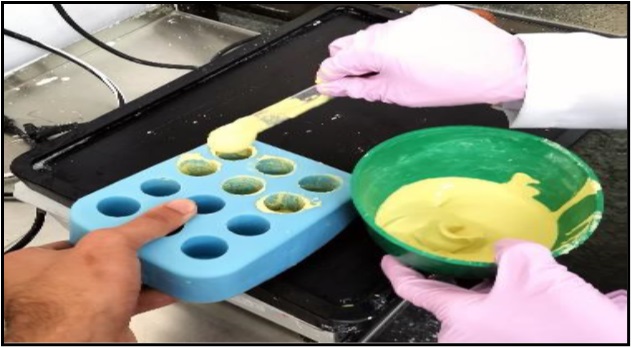Evaluation of the Yttrium Oxide Effect on Some Mechanical Properties of (Type III) Dental Stone
DOI:
https://doi.org/10.51173/jt.v5i4.1905Keywords:
Type III Dental Stone, Yttrium Oxide, Surface Hardness, Compressive StrengthAbstract
For many years, gypsum compounds have been used in dentistry. They're used to make casts for various dental laboratory operations. Gypsum products have important characteristics such as "quality, abrasion resistance, compressive strength, hardness, linear setting expansion during setting, and detail replication". Additionally, the use of additives such as gum arabic, ferric oxide, calcium oxide, and calcium carbonate has greatly improved the compressive strength of gypsum products. The purpose of this study was to investigate the effects of yttrium oxide (Y2O3) addition on the hardness and compressive strength of dental stones. Thirty dental stone specimens of (type III) were prepared and separated into (3) groups: group (A) control group, no additives, group (B) 3% Y2O3, and group (C) 5% Y2O3. The control and experimental groups' mechanical parameters (surface hardness and compressive strength) were measured, and a Shore D hardness tester was used to indent the specimens. An electronic universal testing apparatus with computer control was used to conduct the compressive strength test. The Tukey-HSD test found no difference in surface hardness between the control and experimental groups, a non-significant difference in compressive strength between the control group and dental stone +3% Y2O3, and a significant difference in compressive strength between the control group and dental stone +5% Y2O3. Between dental stones with 3% and 5% Y2O3, there was a substantial difference in compressive strength. The addition of yttrium oxide at weight ratios of 3% and 5% to dental stone did not affect the surface hardness. The addition of 5% yttrium oxide decreased the compressive strengths.
Downloads
References
Hamdy, T.M., A. Abdelnabi, and R.M. Abdelraouf, Reinforced dental plaster with low setting expansion and enhanced microhardness. Bulletin of the National Research Centre, 44(1), p. 1-7, 2020, https://doi.org/10.1186/s42269-020-00334-8.
Kenyon, B.J., et al., Dimensional accuracy of 7 die materials. Journal of Prosthodontics: Implant, Esthetic and Reconstructive Dentistry, 14(1), p. 25-31, 2005, https://doi.org/10.1111/j.1532-849X.2005.00007.x.
Anusavice, K.J., Phillips materiais dentários. Elsevier Brasil, 2013. https://www.amazon.com.br/Phillips-Kenneth-Rawls-Chiayi-Anusavice/dp/8535268189.
Rosenstiel, S.F., et al., Contemporary fixed prosthodontics. St. Louis. Mosby, Inc, 2001. p. 380-416. https://books.google.com/books/about/Contemporary_Fixed_Prosthodontics.html?id=mSJxQgAACAAJ.
Heshmati, R.H., et al., Delayed linear expansion of improved dental stone. The journal of prosthetic dentistry, 88(1), p. 26-31, 2002 https://doi.org/10.1067/mpr.2002.127653.
Harris, P.E., et al., Alterations of surface hardness with gypsum die hardeners. The Journal of prosthetic dentistry, 92(1), p. 35-38, 2004, https://doi.org/10.1016/j.prosdent.2004.04.002.
Sakaguchi, R.L. and J.M. Powers, Craig's restorative dental materials-e-book. 2011: Elsevier Health Sciences. http://dl.konkur.in/post/Book/Dentistry/Craig%27s-Restorative-Dental-Materials-14th-Edition-2019-%5Bkonkur.in%5D.pdf.
Duke, P., et al., Study of the physical properties of type IV gypsum, resin-containing, and epoxy die materials. The Journal of prosthetic dentistry, 83(4), p. 466-473, 2000, https://doi.org/10.1016/S0022-3913(00)70043-6.
Aljubori, O.M. and A.M.A. Aljafery, Evaluation of the Linear Dimensional Changes and Hardness of Gypsum Product/Stone Type Ⅳ after Adding Silica Nanoparticles. Nano Biomedicine and Engineering, 12(3), p. 227-231, 2020, https://doi.org/10.5101/nbe.v12i3.p227-231.
Rajakumar, G., et al., Yttrium oxide nanoparticle synthesis: an overview of methods of preparation and biomedical applications. Applied Sciences, 11(5), p. 2172, 2021, https://doi.org/10.3390/app11052172.
Urapepon, S., P. Sinavarat, and C. Suchatlampong, Effect of die lubricants on the compressive strength and surface hardness of a die stone. M Dent J, 35, p. 111-6, 2015.
Apimanchindakul, C., P. Na Nan, and N. Aimjirakul, Effect of Reinforced Self-Cured Acrylic Resin on Flexural Strength. International Journal of Dentistry, 2022, https://doi.org/10.1155/2022/2698995.
Alraziqi, Z.N.R., Water temperature effect on hardness and flexural strength of (PMMA/TiO2 NPs) for dental applications. Baghdad Science Journal, 19(4), p. 0922-0922, 2022, https://orcid.org/0000-0002-8767-2293.
W. A. A. Alwaeli and M. A. S. Alsegar, “Influence of Different Disinfectants on Surface Hardness of Heat-Polymerized Acrylic Resins utilized for Orthodontic Appliance”, JT, vol. 3, no. 1, pp. 61–65, Mar. 2021, https://doi.org/10.51173/jt.v3i1.286.
Salah, Ali, Ammar Khalid Alnori, and Marwan Zuhair Elias. "Compressive strength of type IV dental stone with Ag nanoparticles." Al-Rafidain Dental Journal, 19(1), 60-69, 2019, https://doi.org/10.33899/rden.2020.126450.1012.
Suri, A., et al., Next generation secondary electron detector with energy analysis capability for SEM. Journal of Microscopy, 279(3), p. 207-211, 2020, https://doi.org/10.1111/jmi.12867.
Mohammad, Q.A., R.H. Hasan, and S.S. Thiab, Effects of different disinfectant additives on compressive strength of dental stone. Journal of Babylon University, 22, 2014, https://www.iasj.net/iasj/download/6e23bfab8706bb2f.
Aghbolaghi, N., et al., Effect of adding silica nanoparticles on the physicochemical properties, antimicrobial action, and the hardness of dental stone type 4. International Journal of Dentistry, 2022, https://doi.org/10.1155/2022/4762017.
Fairhurst, C.W., Restorative dental materials: Edited by Robert G. Craig, Ph. D., and Floyd A. Peyton, D. Sc. Ed. 5. St. Louis, 1975, The CV Mosby Company. 495 pages, illustrated, indexed, 1976, Mosby.
Abdelaziz, K.M., E.C. Combe, and J.S. Hodges, The effect of disinfectants on the properties of dental gypsum: Mechanical properties. Journal of Prosthodontics, 11(3), p. 161-167, 2002, https://doi.org/10.1111/j.1532-849X.2002.00234.x.
Wassell, R., A. Walls, and J. Steele, Crowns and extra-coronal restorations: materials selection. British dental journal, 192(4), p. 199-211, 2002, https://doi.org/10.1038/sj.bdj.4801334.
H. A.-. R. . Khalaf and M. R. . Mohammed, “Effect of disinfectant agents on certain physical and mechanical properties of type IV dental stone”, J Bagh Coll Dent, vol. 26, no. 1, pp. 24–31, Mar. 2014.

Downloads
Published
How to Cite
Issue
Section
License
Copyright (c) 2023 Najwah Yousuf Hameed, Fatima Kadhim Ghadeer, Maytham Jalil Fadheel

This work is licensed under a Creative Commons Attribution 4.0 International License.
















